|
"The human tragedy reaches its climax in the fact that after all the
exertions and sacrifices of hundreds of millions of people... we
lie in the grip of even worse perils than those we have surmounted."
- Winston Churchill
11. The Patterns of War
Why are people so intrigued by the subject of cycles?
One reason is that a knowledge of cycles throws light on the
probabilities of the future.
However, interest in the subject runs deeper than this. There seems
to be a craving within the human heart to find regularity,
dependability, and pattern in the universe. This craving may be at
the bottom of much of scientific research.
Thus the importance of cycles may lie in the fact that they show us
that there is law, order, structure, and pattern in things such as
stock and commodity prices, industrial production, war, and many
other things previously thought structureless.
In general, the study of cycles is the study of pattern, and pattern
is one of half a dozen building blocks from which the universe is
constructed. Of these building blocks the three most important may
be pattern, space, and time.
Without time the universe would have had no duration. It would have
come and gone in an instant.
Without space, it would have been merely a dot, a point.
Without pattern, it would have had no form. It would have been a
jumble - one big fog.
Also important to the existence of the universe as we know it are
matter and energy. Since Einstein and the atom bomb we know that
matter and energy are different forms of the same things, or rather,
interchangeable forms. But there is some reason to think that even
matter and energy are merely patterns of time and space. It doesn't
all boil down to space, time, and pattern, but these three are
basic, and the most important of the three may well be pattern.
Pattern is of two main kinds: patterns of space and patterns of
time. The two are often related as, for example, in the rat-tat-tat
of a boy's stick dragged along a picket fence. The noise is a
pattern in time; the fence is a pattern in space.
Pattern can be simple, like the beat of a tom-tom; or complex, like
the variation of light and shade and form and motion in a young
forest on a sunny summer day.
The same patterns can often be traced in many other things: the
snowflake and the honeycomb, to take a simple example, or the golden
mean, more technically known as the logarithmic spiral, which can be
traced in such diverse things as leaf arrangement, geologic ages,
the curve of a ram's horn or a conch shell, a Beethoven concerto,
and even historical events like commodity and stock prices.
One particular kind of pattern, common to both patterns of space and
patterns of time, is recurrence. Civilizations are born, develop,
mature, stabilize, and die. Art forms recur time and time again in
various cultures. Myths and symbols recur time and again.
War, man's most ignoble pursuit, has unmistakable patterns of
recurrence. What is it that causes us, at rhythmic intervals, to
behave worse than the lowest form of animal life? What forces make
us act as we do? How do we receive their commands? Why do we follow
such a deadly pattern? And why does this pattern manifest itself in
cycles?
When we learn what these forces are, and how they work, we will be
able to use them to our advantage. If we know about them, we can,
hopefully, circumvent them. If not, we can adapt to them.
People often say,
"With cycles as inevitable as they are, isn't it
hopeless to try to do anything about them?"
The answer is:
"Absolutely not! The cyclic force may be inevitable,
but the cyclic result in many instances is subject to our will - if we
know in advance about the force."
Let me give you some examples.
There is absolutely nothing we can do about the force that creates
the cycle of day and night. However, we can adapt to it like the
tiger by developing keener eyesight in the dark. Or we can thwart
the darkness of night by fires, rushes, candles, lamps, and electric
lights.
There is nothing we can do about the force that creates summer and
winter, but we can adapt to it by growing fur. Or we can thwart this
force by shelters (igloos, huts, tents, houses), clothing, and fires
in the winter, and by shade, fans, and air conditioning in the
summer.
There is nothing we can do about the tidal forces, but we adapt to
them by building floating docks. We can even thwart this force as
did the people of Boston and Cambridge when they put a dam across
the Charles River tidal basin, thereby transforming the 12i/£-hour
recurrence of a stinking mud flat into a beautiful lake.
Similarly, if we know about them, we can transform the effects of
other cycles.
Your Seventh Sense
How many senses do you have? Sight, hearing, touch, taste, and
smell. Five? Is that all?
Dr. Joseph Banks Rhine, formerly of Duke University and now head of
the Foundation for Research on the Nature of Man, has spent the
greater part of his lifetime seeking a possible sixth sense in human
beings, a sense that enables us, with some degree of accuracy, to
read other people's minds or to know things it is impossible to know
merely through our conventional five senses, such as the order of
cards in a shuffled deck.
I have spent the greater part of my lifetime trying to discover a
seventh sense, which enables us to detect and respond to certain
forces, possibly electromagnetic, in our environment.
It is this seventh sense, if it exists, that may lead us to the
insane behavior that culminates in wars, stock-market crashes,
depressions, civil riots, and moral chaos.
Why do we have this seventh sense if it is bad for us? It probably
wasn't bad for us in our earlier stages of development, as it
probably helped us survive against the elements and prehistoric
beasts.
Early man presumably gained by the recurring exhilarations and
depressions caused by these energy waves. The time has now come,
however, when man must learn about these forces so that he can adapt
himself to them before he becomes as extinct as the dinosaur.
Our work makes it abundantly clear that, directly or indirectly, man
is attuned to something like electric signals or magnetic waves. It
is true that for the most part he does not "hear" these signals, but
they do affect him and they do cause many of the disturbances to
which he is now subjected.
And the greatest of these is war.
War, Our Way of Life
Man is the most aggressive and deadly animal in the world.
Unlike other animals who normally will kill only for food or in
self-defense, man will commit murder singly or en masse in a war
with little provocation or motive. In the past 3,400 years the world
has known little more than 200 years of absolute peace. But even
war, habitual as it may be, is not a continuous thing with us. It
occurs in cycles - and I consider the work I have done in respect to
cycles in war by all odds the most important achievement of my
lifetime.
Yet our research and discoveries in this most important of
all human behaviors would not have borne fruit without the
monumental efforts of the late Professor Raymond H. Wheeler.
As already mentioned, Professor Wheeler, a professor of psychology
at the University of Kansas and president of the Kansas
Academy of Sciences, summarized all of recorded history. His War
Indexes were an incidental by-product of that work. History books
and historians have always made much of war, so Professor Wheeler
and his staff were able to assemble in their Indexes of
International War Battles and Civil War Battles the longest, most
complete, and most precisely dated series of figures that exists in
all recorded history.
Wheeler's method of compiling his index was to assign numerical
ratings to every recorded battle. To a mild engagement he gave a
value of one, to a moderately severe engagement he gave a value of
two, and to a very heavy engagement he assigned a value of three. By
adding all these battle ratings for a twelve-month period one would
have a numerical rating for that particular year that could be
plotted on a graph.
The War Index was used by Professor Wheeler to show a relationship
between shifting temperatures in the earth's climate and man's
proclivity for war. Warm periods, he noted, were the time of
dictators and international wars, while cold periods produced civil
unrest and democracy.
His compilations were made without any
preconceived notions of cycles, but he did note that there were
recurrences of drought and civil war at approximately 170-year
intervals and that every third of these drought-civil war periods
was more pronounced, thus creating a longer cycle of 510 years.
He
also observed shorter rhythms, especially one of approximately
twenty-three years.
Do Wars Come in Cycles?
Soon after North Korean infantry and tanks crossed the 38th parallel
on June 25, 1950, those of us connected with the Foundation for the
Study of Cycles were confronted, countless times each day, with one
question:
"Do wars come in cycles?"
As the Foundation's director, I
found it almost impossible to give an interview or address a group
without having to reply to this same query. My reply, which was that
they had always come this way in the past, was not sufficient. It
satisfied neither the interrogator nor myself.
Then we discovered Professor Wheeler and his Index of International
War Battles, and late in 1950 we began our research into the cycles
of war - research that still continues, and now at a considerably
accelerated pace because of computers.
During those early days a frieze hung on one wall of my study. It
was nearly sixteen feet in length and showed every single battle of
recorded history from 600 B.C. to A.D. 1952. The frieze consisted of
enlargements of charts prepared by Professor Wheeler.
For each year
little battles, wherever they occurred in the world, were shown by
short blocks, medium-sized battles were shown by medium-length
blocks, and major engagements were shown by long blocks. These
blocks, piled on one another, created a single long vertical bar
that indicated the severity of man's warlike behavior for that
particular year.
Think of a big city skyline at twilight and you
will have a fairly accurate picture of what my frieze looked like.
By 1952 I had identified and isolated four cycles in the Index of
International Battles.
The 142-Year Cycle in War
As you can see in this amazing chart (Figure 45), since A.D. 1100,
international battles have tended to come in rhythmic cycles that
average 142 years in length.
(For some unknown reason, from 600 B.C.
to A.D. 900 the major cycle in war averaged about 163.5 years in
length. No other figures that I know of have switched cycles like
this. It is very baffling.)
This 142-year pattern calls for a more than average number of
battles for the seventy-one-year period from 1914 to 1985 and a less
than average number of battles for the seventy-one-year period from
1985 to 2056.
If, as Professor Wheeler and others believe, there is a relationship
between climate and man's belligerency, there may be cycles of about
142 years in various physical reflections of our climate here on
earth.
These may include the alternate thickness and thinness of
tree rings, the thicknesses of sedimentary rock deposits, and the
flood levels of great rivers like the Nile, where records are
available back over hundreds of years.
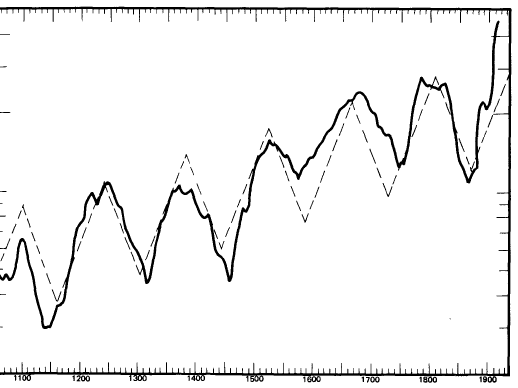
Fig. 45.
The 142-Year Cycle in International Battles, 1050-1915
The 57-Year Cycle in War
In January 1951 I reported on a 57-year cycle (Figure 46) in war.
Although the figures in my possession at the time enabled me to
trace this cycle backward through only three complete cycles, I
pointed out that the wave was clear enough so that prudent men could
not ignore the possibility that the next twenty-five or thirty years
would see an increasing number of international battles.
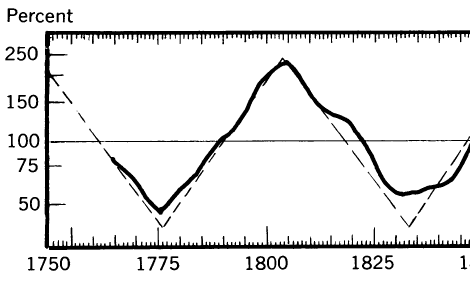
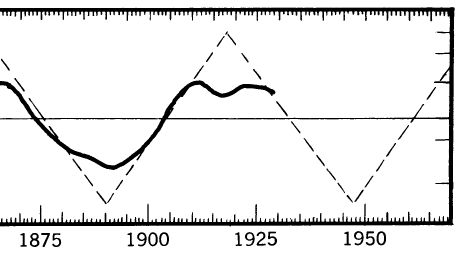
Fig. 46.
The 57-Year Cycle in International Battles, 1765-1930
The 22 1/5-Year Cycle in War
In February 1951 I reported on a twenty-two-year cycle in war. At
first, I had traced it back through twenty-five repetitions to the
year 1400 (Figure 47) .
Then, in 1956, I traced it all the way back to 600 B.C., and I had
the longest continuous series of waves I had ever found - 116
repetitions of a cycle over a period of 2,500 years! The odds of
this cycle occurring purely by chance are only 8 in 10,000. The
continuous presence of a cycle of this length for 2,500 years
explodes the idea that wars come when a new generation that does not
know the horror of war grows up.
Behavior resulting from such a cause
could not possibly be as regular as this.


Fig. 47.
The 22 1/5-Year Cycle in International Battles, 1415-1930
Remember that
these are worldwide figures.
Only in the last few years have we had
worldwide wars. Over the years war weariness in Greece, let us say,
could not possibly account for war weariness in China. Moreover,
even for one country war weariness could not possibly, by itself,
maintain a constant cycle continuously in step with previous war
weariness in other centuries. Some accidental factors would make a
war come early or late, and a new timing for war weariness would
result.
In the years since its discovery the length of this particular cycle
has been refined to 21.98 years.
The 11 1/5-Year Cycle in War
The 1114-year cycle (Figure 48) has also been traced back to 600
B.C. It could not have been chance more often than 18 times in
10,000. It has recently been refined to an average wavelength of
11.241 years.
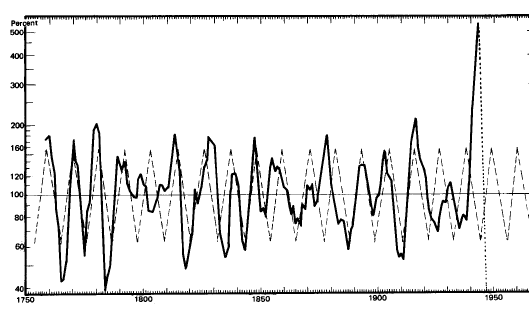
Fig. 48.
The 11 1/5-Year Cycle in International Battles, 1760-1947
The War Prediction
In June 1952 I combined the 142-year cycle, the 57-year cycle, the
22i/5-year cycle, and the 1114-year cycle (see Figure 49).
The combination (synthesis), as represented by the bottom heavy line
of Figure 49, was then projected into the future as a forecast.
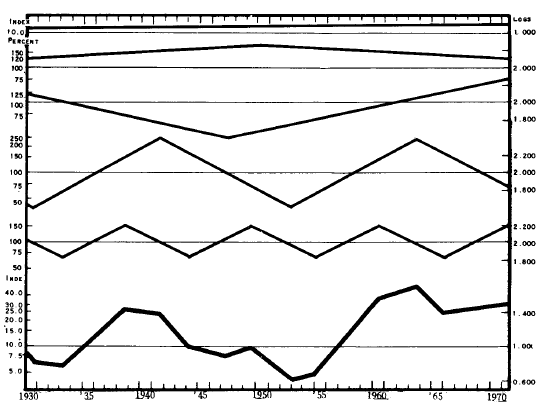
Fig. 49.
The War Cycles,
Combined, 1930-1970
This chart depicts (reading from the top down) the trend of wars,
the
142-year, the 57-year, the 22 1/5-year, and the 11 1/5-year cycles.
The bottom
heavy line brings all these elements together in a synthesis or
combination.
This forecast has come true for the main structure of international
battles, for seventeen years! Here is another chart (Figure 50)
showing the synthesis (broken line) projected to 1975 compared with
the actual index to 1958, its most recent value.
Of course, this forecast was very crude. It used very few cycles. It
used no cycles shorter than eleven years, which is like trying to
paint a portrait with the foot of an elephant for a brush. All the
forecast really said is that times would be rough the world over, in
the 1960's, with the possibility that there would be a double peak,
the first one in the early sixties and the second one at the end of
the decade. The middle 1970's should be reasonably peaceful.
As things actually unfolded, there was a bit of a peak in the first
half of the 1960's (India and China, Holland and Indonesia, Syria
and Egypt, Tibet and China, etc.), but, of course, these minor
skirmishes were completely overshadowed in the latter part of the
1960's by the war in Vietnam.
Since the work of 1952 four additional cycles in war have been
discovered.

Fig. 50.
Index of International Battles, 1820-1958
The solid line represents the actual Index of International Battles,
plus one.
The broken line is the synthesis, or combination, of
cycles from the bottom of Figure 49
extended backward for 90 years
to 1820. As you will note, even with the use of only four cycles,
the synthesis comes fairly close to depicting the ebb and flow of
international battles over this span of time.
Three, with average wavelengths of 17.71, 17.31, and
5.98 years, have been traced all the way back to 600 B.C.
The fourth
cycle has a most unusual pattern. It alternates between 9.6-year
cycles (remember the Canadian lynx?) and 12.35-year cycles for spans
of 86.4 years, each clearly visible in the War Index, wave by wave,
since A.D. 562.
These cycles, and others that we now have hints of,
will undoubtedly modify the original projection made in 1952.
The Behavior of Wars
There is one aspect in the cycles of war that I find particularly
fascinating. International battles clearly have their counterparts
in both biological and economic cycles.
By a "biological" cycle I
mean one that expresses itself predominantly in biological
phenomena, such as animal abundance. By an "economic" cycle I mean
one that expresses itself predominantly in economic phenomena, such
as prices and production.
It is rare indeed for a phenomenon to
evidence both kinds of cycles, but war does. For example, the
9.6-year cycle in war can also be found in forty-two different
biological phenomena. On the other hand, the 17.7-year cycle in war
is primarily an economic cycle.
As international war is sensitive to cyclic forces that are normally
responded to only by animals and also to cyclic forces that are
normally responded to only by men in their economic capacity, we may
think of it as both an economic and a biological phenomenon. This is
most interesting and unusual.
If we knew the particular aspect of animals, or of men, that
responds to cyclic forces and the aspect of man as a producer and
investor that responds to different cyclic forces, we might have an
additional clue as to the causes and nature of war cycles in
general.
How should we interpret these war cycles?
In my own mind I picture
the space in which we live as filled with forces that alternately
stimulate and depress all human beings - make them more or less
optimistic, or make them more or less fearful. These forces do not
control us, they merely influence us. They create a climate that is
sometimes more favorable to war and sometimes less favorable.
War
will come without the stimulus of these forces and wars will be
avoided in spite of these stimuli, but, on the average, the
probabilities for war are greater when the "climate" is right.
The evidence suggests that one of the major causes of war, if not
the major cause, may be mass hysteria or combativeness, which occurs
at reasonably regular rhythmic intervals.
What mysterious forces cause these war cycles, how they operate, and
how we can control them - or their effects - may, in this nuclear age,
be the most important discovery ever made by man.
Back to Contents
|







